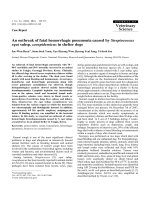Confirmation of bacterial leaf streak of rice caused by Xanthomonas oryzae pv. oryzicola in Vietnam
Bạn đang xem bản rút gọn của tài liệu. Xem và tải ngay bản đầy đủ của tài liệu tại đây (392.33 KB, 3 trang )
Seediscussions,stats,andauthorprofilesforthispublicationat: />
ConfirmationofBacterialLeafStreakofRice
CausedbyXanthomonasoryzaepv.oryzicolain
Vietnam
ArticleinPlantDisease·December2015
DOI:10.1094/PDIS-03-15-0289-PDN
CITATIONS
READS
0
159
9authors,including:
Trantu
HongThiNguyen
InstituteofResearchforDevelopment
AgriculturalGeneticsInstitute
4PUBLICATIONS1CITATION
15PUBLICATIONS23CITATIONS
SEEPROFILE
SEEPROFILE
SzurekBoris
RalfKoebnik
InstituteofResearchforDevelopment
InstituteofResearchforDevelopment
187PUBLICATIONS2,142CITATIONS
193PUBLICATIONS3,812CITATIONS
SEEPROFILE
SEEPROFILE
Someoftheauthorsofthispublicationarealsoworkingontheserelatedprojects:
Pantoeaspp,anewthreattoriceproductioninAfricasouthoftheSaharaViewproject
Diversityofblast,RiceYellowMottleVirus,Pantoeaspp.andSphingomonasspp.inAfricaand
screeningricegermplasmfordiseaseresistanceViewproject
AllcontentfollowingthispagewasuploadedbyRalfKoebnikon27May2015.
Theuserhasrequestedenhancementofthedownloadedfile.
Plant Disease Journal - 0(ja): - Abstract
27/05/2015 10:59
IRD Documentation Welcome Guest user Sign in | Register | Mobile
Journals Home
APS Home
IS-MPMI Home
My Profile
Subscribe
Search
Advanced
Search
Help
Share
Editor-in-Chief: Mark L. Gleason
Published by The American Phytopathological Society
About the current
issue's cover
ISSN: 0191-2917
SEARCH
Enter Keywords
Phytopathology
Plant Disease
MPMI
Advanced Search
Home > Plant Disease > Table of Contents > Abstract
Previous Article | Next Article
Accepted for publication
/>
Confirmation*of*Bacterial*Leaf*Streak*of*Rice
Caused*by*Xanthomonas)oryzae*pv.*oryzicola
in*Vietnam
Quick Links
Add to favorites
E-mail to a colleague
Alert me when new articles
cite this article
Download to citation
manager
Related articles
found in APS Journals
Dr. Tuan Tu Tran, PhD
Resources
About Plant Disease
First Look
Most Downloaded
Articles
Submit a Manuscript
Institut de Recherche pour le Développement (IRD), UMR 186 Interaction Plantes
Microorganismes Environnement (IPME), Montpellier, France;
Miss Nga Nguyen
Vietnam National University of Agriculture, Centre for Plant tropical disease, Hanoi, Viet
Nam;
Customer Care
Miss Ngân Phan
About My Password
Vietnam National University of Agriculture, Dept. Molecular Biology and Applied biotech,
Copyright and
Permissions
Hanoi, Hanoi, Viet Nam, 10000;
Plagiarism and Ethics
615 877;
Advertise
This Journal is brought to
you via a subscription
from the IRD
Documentation
Agriculture Genetics Institute, Pham Van Dong street, Hanoi, Viet Nam, 10000, 084 1642
Miss Hong Thi Nguyen
Agricultural Genetics Institute, Mutation and Heterosis, Pham Van Dong, Hanoi, Tuliem, Viet
Open Access
Nam, 10000;
Dr. Boris Szurek
Institut de Recherche pour le Développement (IRD), UMR 186 Interaction Plantes
Microorganismes Environnement (IPME), Montpellier, France;
Dr. Ralf Koebnik
Institut de Recherche pour le Développement (IRD), UMR 186 Interaction Plantes
Microorganismes Environnement (IPME), Montpellier, France;
Dr. Ham Le Huy
Agricultural Genetics Institute, Hanoi, Viet Nam;
Dr. Cuong Ha Viet
Vietnam National University of Agriculture, Centre for Plant tropical disease, Hanoi, Viet
Nam;
Dr. Sebastien Cunnac, PhD
Institut de Recherche pour le Développement, UMR 186 Interaction Plantes Microorganismes
/>
Page 1 of 2
Plant Disease Journal - 0(ja): - Abstract
27/05/2015 10:59
Environnement (IPME), Montpellier, France;
PDF Print | PDF with Links
The Xanthomonas oryzae species is one of the most important pathogens of rice (Oryza
sativa) (Niño-Liu et al. 2006). In early October of 2013, Vietnamese colleagues reported a
high prevalence of leaf bacterial diseases on irrigated rice fields of the Red River delta
(western coast of the Gulf of Tonkin). We performed an exploratory survey in provinces of
North Vietnam. In the Hanoi, Hung Yen and Nam Dinh provinces, we observed symptoms
reminiscent of bacteria leaf streak (BLS) with variable (<5 to 90%) incidenceprevalence.
While Tthe presence of BLS disease in Vietnam has been recorded in international databases
(Saddler 2002), but to our knowledge, the role of X. oryzae pv. oryzicola as the causal agent
has never been unambiguously established. Collected Field samples exhibited typical BLS
symptoms, such as water-soaked, linear lesions running along the veins and developing into
yellow to brown streaks with yellow droplets of exudates at the surface. Bacteria were
isolated by grinding 4 cm-long leaf pieces in sterile water. Tissue lysates were plated on
semi-selective PSA medium (Poulin et al. 2014) and incubated for 3-4 days at 28°C. Single,
yellow-pigmented, mucoid colonies were further purified on PSA medium. In parallel,
diagnostic multiplex PCR was performed on these colonies for microbial identification (Lang
et al. 2010). In total, isolates from 15 independent samples yielded a PCR profile
characteristic of X. oryzae pv. oryzicola. Six of these strains from the Nam Dinh and Hanoi
provinces were further analyzed. First, a portion of their gyrB gene was sequenced upon
following PCR amplification (Young et al. 2008). All six 780-bp quality-trimmed gyrB
sequences were deposited in GenBank under accession numbers KP872841 to KP872846.
They are identical to the gyrB sequence of strain BLS256 (GenBank CP003057), a reference
strain for the oryzicola pathovar, and exhibited ten polymorphic positions relative to the one
from PXO99A (GenBank CP000967), a oryzae pathovar reference strain. These strains were
also tested for pathogenicity by infiltrating suspensions at 1x108 CFU/ml in water into 4weeks-old O. sativa cv. Nipponbare leaves with a needleless syringe (3 infiltrations x 5 plants
per strain). Unlike water-infiltrated negative controls, all inoculated Lleaves inoculated with
Vietnamese isolates were indistinguishable from positive controls leaves challenged with
strain BLS256. In contrast to water-infiltrated negative controls,: they showed ttypical watersoaked lesions appeared after five days in the greenhouse (27°C, 12-h photoperiod, ~80%
humidity) and ultimately produced yellow exudates resembling those initially observed in rice
fields. For bacterial re-isolation, symptomatic tissue lysates were streaked on PSA medium.
Bacterial colonies showed a typical Xanthomonas morphology and were again assigned to the
oryzicola pathovar by multiplex PCR typing, thus fulfilling Koch's postulates. Theseis data
confirms the status of X. oryzae pv. oryzicola as the causing agent of BLS in two provinces of
Vietnam using modern molecular identification tools. To facilitate inquiries on the phylogeny
and virulence of Vietnamese X. oryzae pv. oryzicola, strains VXO32 and VXO39 have been
deposited in the Collection Française de Bactéries Phytopathogènes under accessions
CFBP8314 and CFBP8315, respectively. J.M. Lang et al. Plant Dis. 94:311, 2010 D.O. Niño-Liu
et al. Mol. Plant Pathol. 7:303, 2006 L. Poulin et al. Plant Dis. 98:1423, 2014. G.S. Saddler.
IMI Descriptions of Fungi and Bacteria 1458. CAB International, 2002. J.M. Young et al. Syst.
Appl. Microbiol. 31:366, 2008.
Journals Home
APS Home
IS-MPMI Home
/>
View publication stats
Contact Us
Privacy
Copyright The American Phytopathological Society
Page 2 of 2









